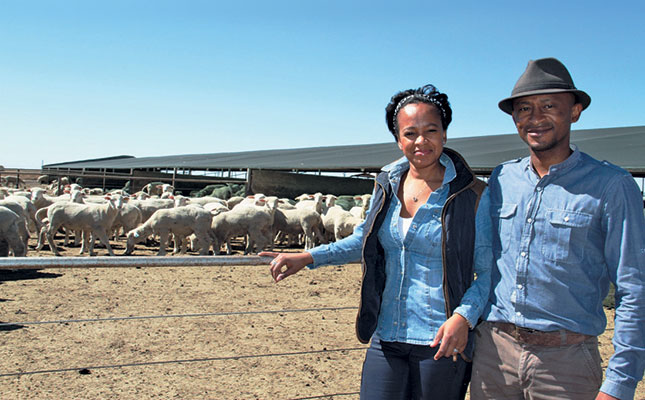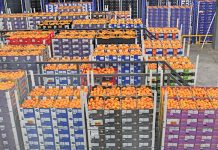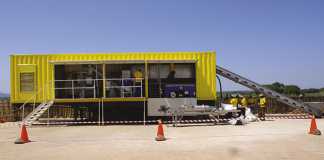
Farming is not about getting rich quickly. You need a long-term strategy, and you have to keep investing in your business. This is according to Mochele Noge, who, with his wife Rosemary, made a brave leap into the farming sector in 2013 when they became part owners of the sheep feedlot Emfuleni Voerkrale, situated on about 200ha close to Frankfort in the eastern Free State.
Explaining why they decided to invest in a farming business, Mochele explains that both he and Rosemary come from entrepreneurial families and having their own business is part of their nature. But, he adds, he is driven by more than his entrepreneurial spirit – he is passionate about property and land.
READ Eastern Cape empowerment project’s R1,5m pineapple crop
“They’re not just investments for me,” he says. “I have an inexplicable romantic and emotional attachment to land. When we decided to buy into Emfuleni Voerkrale, my view was rather simplistic. I figured it was a great property investment and, as a bonus, it could, so I thought, pay for itself. But somehow it took on a life of its own and we managed to get a little more involved than that.”
Getting started
Emfuleni Voerkrale was first established about 11 years ago. The Noges took over the business in March 2013 with partner Ray Strydom. A farmer, Ray assisted by mentoring the couple and managing the feedlot, and helped the Noges to better understand both the business and the culture of farming. Ray recently left the partnership, but remains a source of guidance for Mochele and Rosemary.

“My wife and I are now firmly in the driver’s seat and we view our complementary talents as the secret to our success. I’m more numbers- and detail-orientated, she’s better at marketing,” explains Mochele. Looking back, he says that, as with all businesses, getting
started was extremely tough.
“Setting up our own systems and protocols was time-consuming and more often than not, a process of trial and error,” he recalls.
He admits that he started out knowing absolutely nothing about farming.
“I had to be open-minded and simply prepare myself to learn and absorb as much as I could. I tried to meet as many people as I could and to ask as many questions as I could. One notable challenge was an appreciation of how capital-intensive this type of business can be.”
Since taking over the business, the Noges have made significant changes. These include increasing salaries and including a funeral cover and provident fund as part of their employees’ remuneration, tagging the sheep with radio frequency identification tags to improve record-keeping, and acquiring an abattoir. In addition, they switched from mixing their own feed for the feedlot to buying pre-mixed pellets from Sernick Feeds.
Learning the science of sheep nutrition
“We have a great relationship with the Sernick Group. They have been extremely supportive at the best and worst of times,” says Mochele.
“Our relationship has evolved and we’ve gone so far as to sign a memorandum of agreement wherein we buy their feed and they slaughter our lambs and sell them through their butcheries, giving us retail exposure.”
Getting to grips with the complex science of sheep nutrition was perhaps the most important lesson the Noges had to learn.
“The quality of incoming lambs makes a significant difference in your final output,” says Mochele. “That’s why we buy only from producers who we can trust to deliver animals bred from superior genetics. We prefer to buy in lambs at 30kg, but will buy in animals below that weight occasionally.”
READ Beef cows: Meeting their nutritional needs
Lambs are bought from neighbouring farmers and at auctions.
“Quality is a key issue because you want lambs that’ll grow and respond favourably to your feed and management style.
“Genetics are also critical, so we have strong relationships with the farmers who we know provide us with a constant supply of genetically superior animals.”
Sheep spend on average 60 days at the feedlot. According to Mochele, he and Rosemary aim to achieve an average daily gain of at least 330g/lamb. “We feed a starter ration with a high ratio of lucerne for about a week, which assists the animal in adapting to the feedlot environment,” he says.
“After the adaptation phase, the sheep receive a grower ration for about four weeks. Thereafter, they’re rounded off with a finisher ration in the sixth and final week prior to being marketed for slaughter.”
The normal daily average consumption in the cycle is about 4% of the animal’s body weight. This equates to about 1,6kg per sheep per day.
Good quality
All feed is bought in from Sernick Feed in Edenville. Emfuleni Voerkrale decided to switch to pelleted feed after conducting a comparative study to assess the efficiency of different types of feed. The study proved that the high cost of pellets was justified in terms of the results achieved by the feed conversion ratio and average daily gain of the sheep.

Emfuleni Voerkrale has invested in good quality infrastructure that will allow the business to grow. Some of this already existed when the Noges took over. Overall, the facilities include pens for the sheep in the various kraals, storage facilities for the feed, all the required machinery for a high-throughput farm, and a shearing shed as well as classing and weighing facilities (wool is marketed via CMW and BKB).
“As part of the processing and record-keeping aspect there are medicine dispensing facilities where sheep are processed and inspected one at a time,” says Mochele.
Sick sheep are treated in a separate facility offering a warmer, more comfortable environment.
Future plans
The Noges hope to expand the business from its current capacity of 4 000 lambs to its full potential of 10 000 lambs. “This will ensure efficient use of the infrastructure as we’ll be operating at the optimal capacity allowed by the size of the property,” explains Mochele.
Accessing sufficient working capital continues to be a challenge in the current economic climate but the Noges have promising prospects in this regard.
“Future developments will include growing the value proposition and being closer to the end-consumer, as that is where and how we believe we’ll be able to maximise our economic returns and be less exposed to the vagaries of the volatile input costs,” he says.
“The industry seems to be purely price-driven and it’s important for the end-users to be educated on what a good lamb chop looks and tastes like. “Very few people know the difference between lamb and mutton. Even fewer understand and appreciate the various grading levels.”
“Very few people know the difference between lamb and mutton. Even fewer understand and appreciate the various grading levels.”
• Phone Mochele Noge of Emfuleni Voerkrale on 082 600 5373, or send him an email at [email protected].













